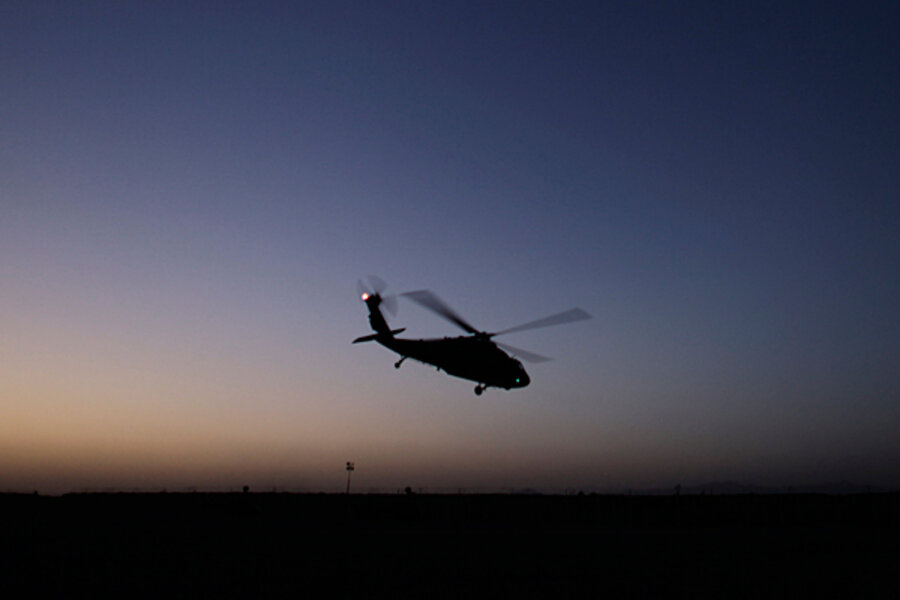Afghanistan helicopter crash makes 2010 deadliest year in Afghanistan war
Loading...
• A daily summary of global reports on security issues.
Nine NATO soldiers died in a helicopter crash Tuesday in Afghanistan, making 2010 officially the deadliest year of the nine-year Afghanistan war.
That somber milestone comes as United States troops take over for British troops in Helmand – one of Afghanistan's most troubled southern provinces –amid an ongoing "surge" designed to bring antigovernment Taliban militants to heel and shore up a fragile central government in Kabul.
The Taliban took immediate responsibility for the deaths, but NATO said the cause of the crash was still under investigation, according to Agence France-Presse.
AFP quoted a provincial spokesman saying that the helicopter went down in Zabul Province in southern Afghanistan, where Taliban still hold sway in many areas. Two other American soldiers, an Afghan soldier, and American civilian were wounded in the crash, The Washington Post reported.
The crash brings total NATO-led coalition deaths to 529 for this year, surpassing last year's 521 deaths, according to a tally from icasualties.org. The US-based monitor, which aggregates information from news reports and military press releases, says total coalition deaths since the CIA and US special forces entered Afghanistan in 2001 have now hit 2,097.
June 2010 remains the most deadly month of the nine-year Afghanistan war, with 103 NATO troops killed, The Christian Science Monitor reported.
Nearly 150,000 coalition troops, about 100,000 of them American, are now battling insurgents in Afghanistan, with a concentration on the southern provinces of Helmand, Kandahar (the Taliban's home), and Zabul (see map of Afghanistan here).
The Los Angeles Times noted that NATO troops rely heavily on helicopters in Afghanistan because there are few passable roads in more remote areas.
Taliban fighters have been unable to shoot down Western helicopters in large numbers, but insurgent fire brought down a Canadian chopper last month in Kandahar province, injuring eight troops. Another helicopter was shot down in June in Helmand province, killing four Western troops.
The summer saw a rash of helicopter crashes, mainly in the south. Another crash in Kandahar province in June killed three Australian servicemen and the US pilot.
President Obama decided in December 2009 to send an additional 30,000 US troops to Afghanistan as part of a counterinsurgency campaign designed to swing popular support from Taliban militants to the central government through a combination of military power and hearts-and-minds public works and outreach. He pledged to begin withdrawing some of those troops in July 2011.
Critics of the current US strategy – including Afghan President Hamid Karzai – have long argued that the Taliban's havens and allies across the border in Pakistan will make it difficult, if not impossible, to defeat them. In one such commentary from 2008, the RAND Corporation's Seth Jones said:
“Every successful insurgency in Afghanistan since 1979 enjoyed safe haven in neighboring countries, and the current insurgency is no different. Right now, the Taliban and other groups are getting help from individuals within Pakistan's government, and until that ends, the region's long-term security is in jeopardy.”
“Solving this problem will require a difficult diplomatic feat: convincing Pakistan's government to undermine the sanctuary on its soil."
But in a recently published interview with Foreign Policy, US Defense Secretary Robert Gates remained optimistic:
"I see the process of transition in Afghanistan being similar to Iraq," Gates said in our interview, "in which we're in the lead, then we're partners [with Afghan security forces], then they're in the lead, then we're in tactical overwatch, and then strategic overwatch. And that will take some time."
Two elements are key here. First, Gates's idea of an endgame is not the Bushian notion that Afghanistan becomes a democracy or even necessarily a stable country, but rather that its security forces can fight the war for the most part by themselves. Second, some US armed forces will end up staying in Afghanistan – just as some (between 30,000 and 50,000) are due to stay in Iraq – for a long while.
"But by the same token," Gates added, "the one thing that I've made clear to everybody is that I'm not going to support a strategy that leads to a stalemate."
Gates says in the interview that the main US goal is realistic: to create an Afghan security force that can fight insurgents on its own, backed by a smaller US military presence that will stay indefinitely. He also says the US will change course if the current strategy proves ineffective.
"If we're not making any headway," Gates said, "then I think we have to look at making adjustments." What kinds of adjustments, he doesn't know. "But we're not just going to plunge ahead with exactly the same strategy if it's clear it's not working."





